|
The Woodland Education Centre |
|
|
The Woodland Education Centre |
|
Ecological Survey 1999
Section 9 Description (Hand Weeded)
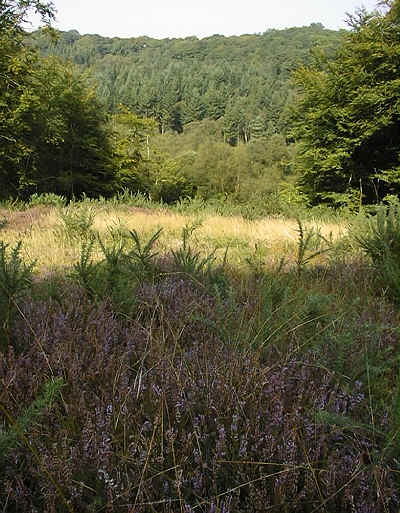 |
Section 9 is
the largest section on the Heathland Restoration Project site. It is more than double the
size of any of the other sections. This section is really a section of two very different halves. The upper half (left) at the western end of the slope was dominated by Heather, Polytrichum formosum, grasses and typical heathland sedges, such as Pill Sedge and Green-ribbed Sedge. Gorse (mid frame, left) was generally neither very tall nor particularly widespread in this section. |
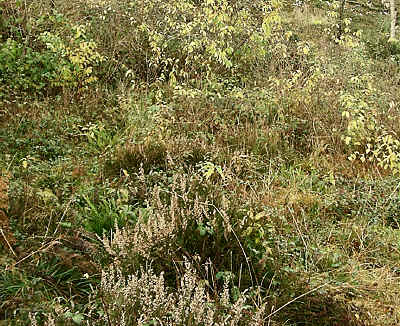 |
The
lower half of the section (left) towards the bottom of the slope, was dominated by brambles, Bracken, rushes
and sedges. There was some Heather here, although much less than in the upper half,
together with a variety of tree species such cherry, birch and willow. The lower half is much wetter and is marshy in places. It is likely that this area is wet because it is being affected by the spring line which is very evident in the neighbouring wet woodland area. |
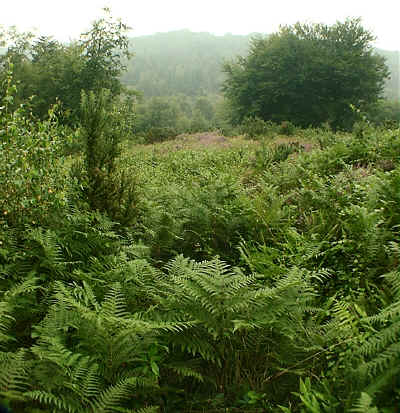 |
Bracken
(left)
was quite widespread in this section, together with a variety of other ferns, such as Hard
Fern and Narrow Buckler Fern. Bluebells were also present earlier in the year, but had died back by the time of the July survey. |
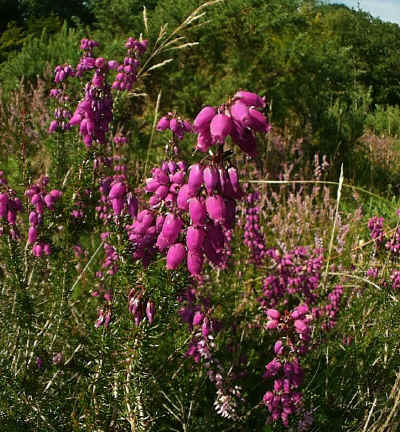 |
Bell Heather (left) had spread in this section and quite large clumps were now present in some areas. |
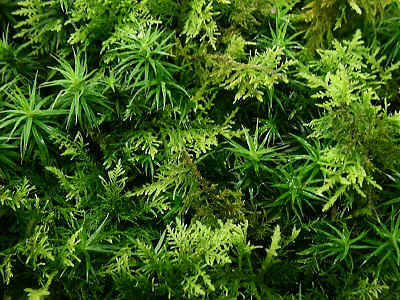 |
Much of
the ground layer in the upper half of the section was dominated by mosses, such as Polytrichum formosum (left - upright spikes)
and Thuidium tamarascinum (left - fern-like growth form). Polytrichum formosum had declined considerably in this section. In 1998, it was found in virtually every single quadrat, while in 1999, its % frequency had declined to only 64%. |
 |
The dominant species overall in this section was Silver Birch. Seedlings of this pioneer tree covered much of the area (left). |
 |
Purple Moor Grass (left), which is a characteristic large, tussocky grass of wetter heaths, had become established in one small area of the lower half of this section. |
Dominant Plants in
Section 9 in 1999
with figures from 1998 for comparison.
Characteristic heath species are in bold print
| Species | Overall % frequency | Mean % Cover (all quadrats) | ||
| 1999 | 1998 | 1999 | 1998 | |
| Silver Birch | 72 | 78 | 12 | 12 |
| Heather | 69 | 59 | 42 | 26 |
| Polytrichum formosum | 69 | 94 | 52 | 33 |
| Bramble | 66 | 69 | 17 | 10 |
| Green-ribbed Sedge | 56 | 53 | 12 | 8 |
| Thuidium tamarascinum | 53 | 53 | 27 | 7 |
| Velvet Bent | 47 | 13 | 12 | 2 |
| Yorkshire Fog | 41 | 47 | 9 | 5 |
| Cherry | 41 | 50 | 5 | 7 |
| Hypnum jutlandicum | 41 | 19 | 24 | 4 |
| Pill Sedge | 38 | 41 | 5 | 4 |
| Eurhynchium praelongum | 38 | 3 | 13 | 0.5 |
| Common Bent | 31 | 38 | 8 | 8 |
| Soft Rush | 31 | 22 | 10 | 2 |
| European Gorse | 28 | 25 | 8 | 6 |
| Percentage frequency = the percentage of the total number of quadrats sampled over the whole site which contain the species. For example, a percentage frequency of 100%, means that the species was found in all quadrats sampled. |
Summary:
Comparison with the previous year:
|
>> Continue to Control Section Description
Ecological Survey 1999 |